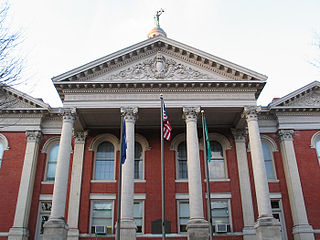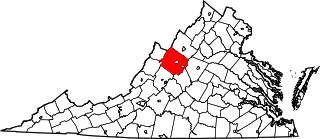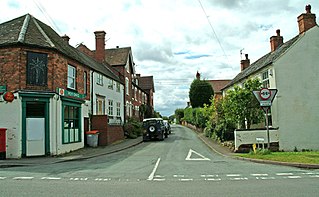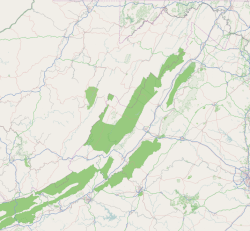
Waynesboro is an independent city in the Commonwealth of Virginia. As of the 2020 census, the population was 22,196.

Harrisonburg is an independent city in the Shenandoah Valley region of the Commonwealth of Virginia in the United States. It is also the county seat of the surrounding Rockingham County, although the two are separate jurisdictions. As of the 2020 census, the population was 51,814. The Bureau of Economic Analysis combines the city of Harrisonburg with Rockingham County for statistical purposes into the Harrisonburg, Virginia Metropolitan Statistical Area, which has a 2011 estimated population of 126,562.

Augusta County is a county in the Shenandoah Valley on the western edge of the Commonwealth of Virginia. The second-largest county of Virginia by total area, it completely surrounds the independent cities of Staunton and Waynesboro. Its county seat is Staunton, but most of the administrative services have offices in neighboring Verona.
Scouting in Virginia has a long history, from the 1910s to the present day, serving thousands of youth in programs that suit the environment in which they live. Many of the local groups and districts took names of historic Virginia Indian tribes in the state.

Strasburg is a town in Shenandoah County, Virginia, United States, which was founded in 1761 by Peter Stover. It is the largest town by population in the county and is known for its grassroots art culture, pottery, antiques, and American Civil War history. The population was 6,398 at the 2010 census.

Woodstock is a town and the county seat of Shenandoah County, Virginia, United States. It has a population of 5,212 according to the 2017 census. Woodstock comprises 3.2 square miles of incorporated area of the town, and is located along the "Seven Bends" of the north fork of the Shenandoah River. While some tourism references list Woodstock as the fourth oldest town in Virginia, the area was sparsely settled and perhaps platted in 1752 or shortly thereafter, but the town was actually established by charter in 1761. While there are a number of Virginia towns closer to the eastern seaboard that claim earlier founding dates, Woodstock was one of the first towns west of the Blue Ridge.

The Shenandoah Valley is a geographic valley and cultural region of western Virginia and the Eastern Panhandle of West Virginia in the United States. The valley is bounded to the east by the Blue Ridge Mountains, to the west by the eastern front of the Ridge-and-Valley Appalachians, to the north by the Potomac River and to the south by the James River. The cultural region covers a larger area that includes all of the valley plus the Virginia highlands to the west, and the Roanoke Valley to the south. It is physiographically located within the Ridge and Valley province and is a portion of the Great Appalachian Valley.

The Battle of New Market was fought on May 15, 1864, in Virginia during the Valley Campaigns of 1864 in the American Civil War. A makeshift Confederate army of 4,100 men defeated the larger Army of the Shenandoah under Major General Franz Sigel, delaying the capture of Staunton by several weeks.

The Battle of Piedmont was fought June 5, 1864, in the village of Piedmont, Augusta County, Virginia. Union Maj. Gen. David Hunter engaged Confederates under Brig. Gen. William E. "Grumble" Jones north of Piedmont. After severe fighting, Jones was killed and the Confederates were routed. Hunter occupied Staunton on June 6 and soon began to advance on Lynchburg, destroying military stores and public property in his wake.

Staunton is an independent city in the U.S. Commonwealth of Virginia. As of the 2020 census, the population was 25,750. In Virginia, independent cities are separate jurisdictions from the counties that surround them, so the government offices of Augusta County are in Verona, which is contiguous to Staunton. Staunton is a principal city of the Staunton-Waynesboro Metropolitan Statistical Area, which had a 2010 population of 118,502. Staunton is known for being the birthplace of Woodrow Wilson, the 28th U.S. president, and as the home of Mary Baldwin University, historically a women's college. The city is also home to Stuart Hall, a private co-ed preparatory school, as well as the Virginia School for the Deaf and Blind. It was the first city in the United States with a fully defined city manager system.

Hartlebury is a village and civil parish in Worcestershire, England which is in Wychavon district centred 3.6 miles (5.8 km) south of Kidderminster. The civil parish registered a population of 2,549 in the 2001 Census.
Shenandoah Valley Regional Airport is in Weyers Cave, Virginia, United States, 12 miles northeast of Staunton. It is used for general aviation and is served by one airline, subsidized by the Essential Air Service program.
The Valley Baseball League is an NCAA and MLB-sanctioned collegiate summer baseball league in the Shenandoah Valley region of Virginia. Each Valley Baseball League season consists of 42 games played during summer, beginning the Friday after Memorial Day and continuing into late July. Playoffs immediately follow and culminate in early August.

Staunton station is an Amtrak train station in Staunton, Virginia, located in the downtown Wharf Area Historic District of the city. It is served by Amtrak's Cardinal, which runs between New York and Chicago.
Christopher B. Saxman is an American politician of the Republican Party. He is a former member of the Virginia House of Delegates, representing the 20th District from 2002 to his retirement in 2010. The district includes the City of Staunton, the western part of Augusta County, the southern part of Rockingham County, and all of Highland County.

The Andrew Zirkle Mill is a 1760s era grist mill located in the southern end of Shenandoah County, Virginia. The mill was added to the National Register of Historic Places in 1983 after being restored by Glenn Hofecker, the owner at the time. The mill is cited as a prime example of the architecture and construction of grist mills and manufacturing facilities of its era.

Andrei Kushnir is an American fine art painter. He is known for his landscapes, city views, and seascapes, but also has created genre, portraits and still life works. He is a resident of Maryland, with a studio in Washington, D.C.
John L. Heatwole (1948–2006) was an artist, historian, tour guide, and storyteller who gathered and preserved hundreds of oral history and folklore stories from the Shenandoah Valley and throughout Virginia and West Virginia through writings, lectures, and radio programs.

The Shenandoah Valley region of Virginia and neighboring parts of West Virginia is home to a long-established German-American community dating back to the 17th century. The earliest German settlers to Shenandoah, sometimes known as the Shenandoah Deitsch or the Valley Dutch, were Pennsylvania Dutch migrants who arrived from southeastern Pennsylvania. These German settlers travelled southward along the Great Wagon Road. The Pennsylvania Dutch are the descendants of German, Swiss, and Alsatian Protestants who began settling in Pennsylvania during the 1600s. These German refugees had fled the Rhineland-Palatinate region of southwestern Germany due to religious and political persecution during repeated invasions by French troops. From the colonial period to the early 1900s, people of Germanic heritage formed the social and economic backbone of the Shenandoah Valley. The majority of the German settlers in the valley belonged to Anabaptist denominations such as the Mennonites, the Dunkers, and others. Smaller numbers were German Catholics or German Jews. Due to both economic reasons and Anabaptist objections to slavery, the German settlers of the valley owned few slaves, and consequently the area has never had a large African-American population. The earliest European settlers of the Shenandoah Valley were the Germans, who mostly settled in the northern portions of the valley, and the Scotch-Irish who mostly settled in the southern portions of the valley. The German language was commonly spoken in Shenandoah until World War I, when anti-German sentiment resulted in many German-Americans abandoning their language and customs in order to assimilate into the cultural mainstream. The German contribution to the culture of the Shenandoah Valley has been substantial, with Germans popularizing Pennsylvania Dutch cuisine and shape note singing. While most white Southerners have been of Anglo-Saxon and Celtic stock, the German migration to Shenandoah has given the area some ethnic diversity, "a characteristic more Pennsylvanian then Virginian". While the valley is geographically Southern, this German contribution from the Mid-Atlantic has "made it appear Northern." In the 21st century, the Shenandoah Valley and Harrisonburg in particular have become known as a haven for refugees, with Mennonites and the Church of the Brethren playing a prominent role in helping resettle migrants from Latin America and elsewhere. The Mennonites and the Brethren have played an active role due to their denominational emphasis on pacifism and social justice, along with the Mennonite and Brethren history of being refugees from religious persecution in Europe. Current immigration of Hispanics from the Caribbean, Central and South America is changing the valley's culture.

















